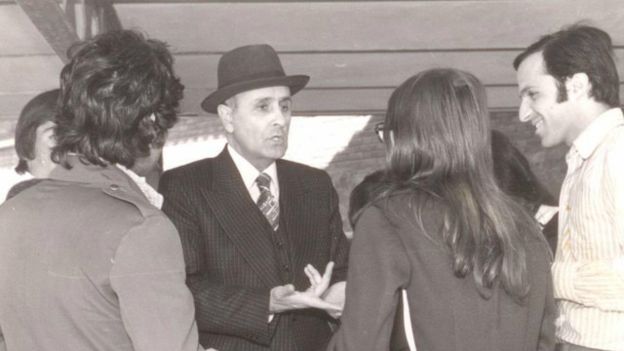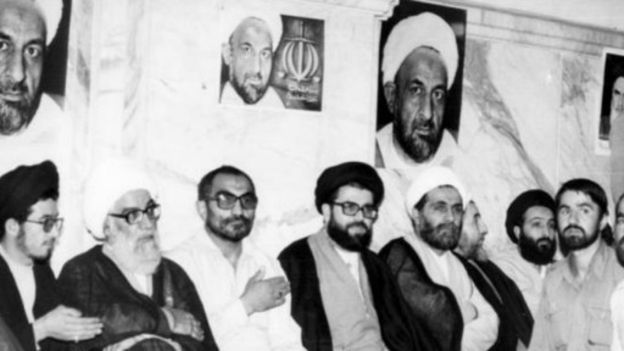Source: bbc.com/persian
Sepehr Atefi
11 October 2015
Translation by Iran Press Watch
On 11 November 1979, Dr. Alimorad Davoodi, secretary of the National Spiritual Assembly (NSA) of the Baha’is of Iran, and professor of philosophy at Tehran University, went for his customary afternoon walk in Tehran’s Laleh Park, and never returned.
Numerous threatening phone calls in the preceding days, and his friends’ investigations on the day itself, clearly suggest abduction.
His daughter, Marjan Davoodi, who was 18 at the time, remembers, “We went to the park with a few of his friends to look for him. The park security guard said that a jeep drove up, and he was forced into the car. We assumed that the jeep belonged to the government, since most cars were not allowed to enter the park. When the friends returned to the park later that day, the guard denied everything.”
Alimorad Davoodi was not the first Baha’i to be abducted. The abductions had begun several months earlier, with the kidnapping of Mohammad Movahed. He was born into a clerical family in Shiraz, and had undergone years of Islamic studies, during which he learned about and accepted the Baha’i Faith. His becoming a Baha’i was so unbelievable to his family and friends that they sent him to a mental institution, and later transferred him to Tehran. In spite of numerous meetings, lengthy discussions and even threats, he never renounced or concealed his beliefs. Years later, after the Revolution, the pressure increased. Finally, after several interrogation sessions and a summons to the Revolutionary Committee, he was abducted in the street, on May 1979. The next abduction that created great anxiety in the Baha’i community took place in December of the same year. Ruhi Roshani, secretary of the Local Spiritual Assembly (LSA) of Tehran, who had been the target of threats from religious fanatics after the publication of his book, “Khatamiyyat” (the belief that the Prophet Mohammad was the last messenger of God) also disappeared. His fate, like that of Davoodi and Movahed, remains unknown.
Abduction of the Members of the NSA of Iran and Execution of the Members of the second NSA
With increasing pressure on Baha’i institutions, two Baha’is in Tabriz were accused of “spying for Israel” and executed in April 1980. Baha’i institutions, or “assemblies”, tend to the administrative affairs of the Baha’i community, and are comprised of nine members elected by the Baha’i community in each city or village.
The denial of any involvement by government authorities amplified the rumors regarding the fate of the missing persons. Marjan Davoodi states, “We appealed to practically all the responsible agencies, but they all denied involvement. For a long time we hoped we would find him, but we suspected that, like others during that period, he was being tortured and forced to recant his faith or to plead guilty to a false charge. These speculations and rumors were extremely distressing for us.”
Under similar circumstances, several men went to the home of Dr. Hossein Naji, a member of the NSA of Iran, to arrest him; not finding him at home, they took his wife into custody. Vajdieh Rezvani, Hossein Naji’s wife, relates: “They came to our house four times; each time there were seven or eight armed men. The first time they said they were searching for weapons, but the next two times they wanted to see Dr. Naji, and once they took him for interrogation.”
Hossein Naji wrote to Ayatollah Khomeini, President Abul-Hassan Bani-Sadr, Minister of Health Hadi Manafi, and Attorney General of the Revolutionary Court Ayatollah Ali Qodusi, describing the raids of his home by armed men and the arrest of his wife, and he requested an investigation, but his pleas met with a complete lack of response by the authorities, and no agency accepted responsibility for the arrest of his wife.
Finally, on 21 August 1980, armed men arrested all the members of the NSA, as well as two of their colleagues, during a regular NSA meeting. The 11 persons abducted during the raid were never seen again by friends or family.
Investigation into the disappearances began immediately. The families met with the Attorney General of the Revolutionary Court, the Head of the Iranian Judiciary, and the Speaker of Parliament.
Vajdieh Rezvani recounts, “We went to every place we could think of… this prison, that prison; we went to see Ayatollah Beheshti, Ayatollah Montazeri’s son, Ayatollah Behjat, Ayatollah Gilani… they all denied any knowledge, but we found out later that they had executed all of them the very first night… although after 35 years we still don’t know what really happened.”
In a meeting with the Speaker of Parliament, Akbar Hashemi Rafsanjani, he promised to investigate the disappearances. A few days later he confirmed that an order had been issued for the arrest of the eleven Baha’is, but that they must remain incommunicado until the interrogations were completed. Less than a month later, Rafsanjani denied his previous statement and blamed the disappearances on an independent group. The members of the Baha’i community of Iran also suspected other groups – including the Hojjatieh Society* – of involvement in the disappearances.
On 13 December 1981, during one of the rare occasions when eight of the nine members of the replacement NSA were meeting, all of them were arrested. Farideh Samimi recounts, “…they did not show us a warrant; Mr. Amin Amin, who was a lawyer, asked if they had a warrant for our arrest; they did not need a warrant – their word was law.”
_______________________________________
Mina Yazdani, a historian, comments on the extent of the government’s role in the abductions**: “In the case of Dr. Davoodi and Mohammad Movahed, there is no question that some government agencies were involved. The fact that all pleas for justice went unheeded, and it was leaked some time later that an influential and powerful member of the clergy had ordered the execution of Mohammad Movahed, leaves no doubt that some branches of the government were implicated.”
_______________________________________
Following the abduction of the first NSA formed after the Revolution, a second NSA was convened. This NSA attended to the affairs of the Baha’i community for a year under the most difficult circumstances. The arrest and execution of the membership of the LSAs of Yazd, Hamadan, Tehran and Tabriz, and the execution by firing squad of two Baha’is in Mashad, were some of the ordeals the Baha’i community experienced during 1980 and 81.
Eventually, on 27 December 1981, the eight members of the NSA were put to death by firing squad. Their execution was initially denied, but it was later confirmed by then Head of the Judiciary Ayatollah Ardebili, who announced that they had been put to death on the grounds of “espionage for foreign powers.” Thus, the arrest and execution of Baha’is became official.
Dissolution of Baha’i institutions and execution of several members of the third NSA
On 29 August 1983, Hassan Mousavi Tabrizi, Attorney General of the Revolutionary Court, stated in an interview, “Baha’is spy for others; they are trouble-makers… Today, I proclaim that due to their subversive and immoral activities, Baha’i institutions are considered by the Attorney General of the Revolutionary Court of the Islamic Republic to be renegades and conspirators, and any collaboration with them is forbidden.”
In its last message to the Baha’i friends of Iran, the third NSA announced the suspension of all Baha’i activities in accordance with the Baha’i principle of obedience to the laws of the government; they simultaneously sent an open letter to two thousand of the top high-ranking and influential members of the government, requesting an end to the persecution, arrests, imprisonment, torture and execution of Baha’is. In one part of the letter they ask, “How can an 85-year-old man from Yazd, who has never left his village, be a spy? How can you accuse students, housewives, innocent young girls, and elderly men and women of spying? What documents and secret information did they have? What spy apparatus did they possess?”
Nonetheless, the persecution of Baha’is and harassment of Local and National Spiritual Assemblies did not stop; in the following months seven members of the third NSA formed after the Revolution – Jahangir Hedayati, Shapour Markazi, Farhad Asdaqi, Farid Behmardi, Ardeshir Akhtari, and Amir Hossein Naderi – were arrested and executed.
Baha’is and the Islamic Revolution
Although Baha’is were discriminated against during the Pahlavi regime as well, with the advent of the Islamic Revolution the discrimination intensified and became institutionalized. The Constitution of the Islamic Republic clearly separates the followers of Shi’a Islam from other recognized religious minorities; by excluding Baha’is as a “non-recognized minority” it prepared the grounds for pressure on Baha’is. Ayatollah Khomeini, who never concealed his hostility against Baha’is, stated in a December 1978 interview with Professor James Cockroft of Rutgers University, in answer to his question regarding political and religious freedoms for Baha’is under the new regime: “Freedom will not be given to people who are harmful for the country.”
Thus, it was not surprising that from the early years of the Revolution Baha’is were persecuted by their past enemies as well as the ruling powers.
But what was the Baha’i reaction to the Revolution? Mina Yazdani, a professor of history who is a Baha’i, says: “Considering the circumstances and events of that period, for instance the burning of Baha’i homes in Shiraz two months before the Revolution, premonitions of the perils to come were not too far-fetched. Many of us felt that there would be hardships and suffering in the future.”
Confiscation of their property, expulsion from schools and universities, ejection from their jobs, prohibition from legal transactions, etc. – these were some of the outcomes of the Revolution for Baha’is.
Three decades after the Revolution, the human rights of Baha’is have not improved. For instance, seven members of the Baha’i community who administered the affairs of the community in the absence of elected institutions are currently serving 20 years each in prison.
On 14 May 2008, Jamaloddin Khanjani, Fariba Kamalabadi, Afif Naeimi, Saeid Rezaie, Behrouz Tavakkoli, and Vahid Tizfahm were arrested in their homes in a coordinated plan by Revolutionary guards, and were taken to Evin prison. Mahvash Sabet has been in custody in Mashhad since 5 March 2008.
The Baha’i Faith was founded in Iran in 1844. Baha’is represent the largest non-Muslim religious minority in Iran. At the beginning of the 1979 Revolution, their numbers reached 300,000. The affairs of the Baha’i community are administered by an elected body called the Spiritual Assembly.
*For more information regarding the Hojjatieh Society, see https://en.wikipedia.org/wiki/Hojjatieh
**Dr. Yazdani’s full article is available here: https://www.academia.edu/9405045/The_Islamic_Revolution_s_Internal_Other_The_Case_of_Ayatollah_Khomeini_and_the_Baha_is_of_Iran



October 15, 2015 6:05 pm
the world should know about what our fellow Baha’is have endured the last 36 years
October 16, 2015 7:27 pm
The Islamic revolution of Iran and the Islamic Government that followed is a dark blot on the long history of Iran. A disgrace to the Muslim clerical rulers that will never be erased from the dump heap of history.
October 18, 2015 11:45 am
What amazed me was the comment from the wife of one of the executed leaders. She said that when the eight Baha’is were led to the place of their execution, they began embracing each other to farewell. But the executioners suspected something when they saw this expression of affection and shot them even before they reached the place where they were to be executed. Pity for their blindness.
September 5, 2020 3:49 pm
we are nowhere near full comprehension of any of these events.